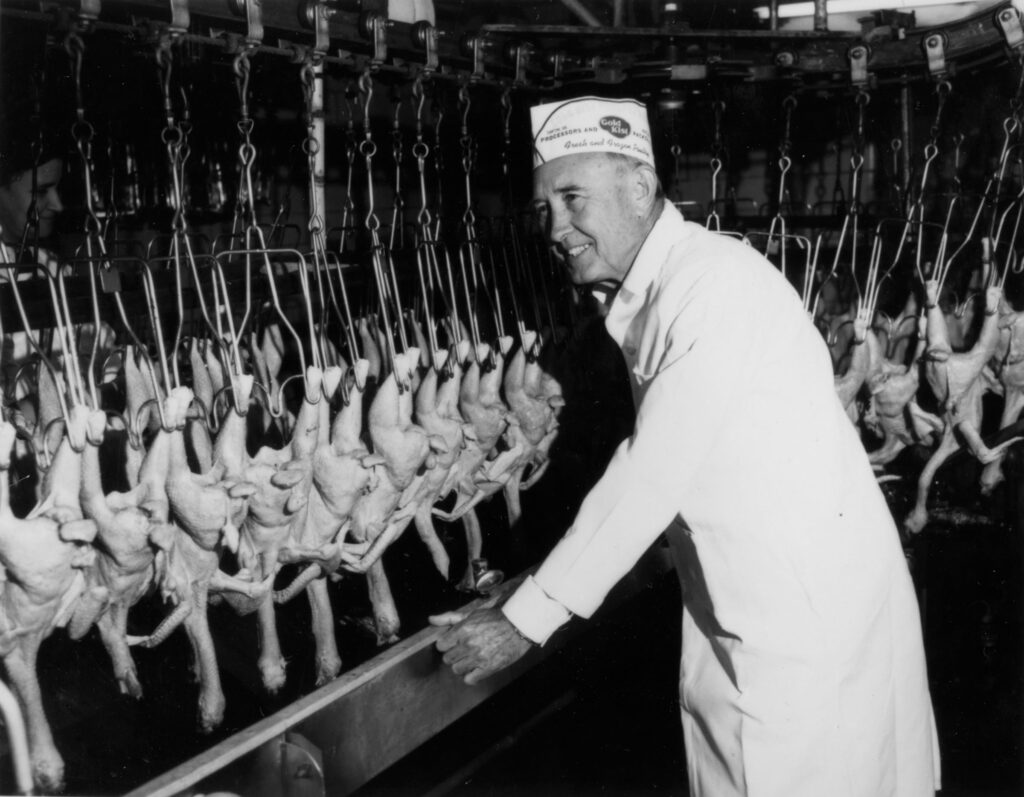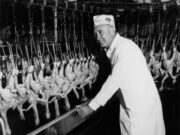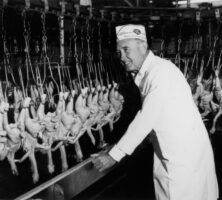Atlanta-based Gold Kist, founded during the Great Depression by a young agronomy instructor at the University of Georgia, merged in 2006 with rival Pilgrim’s Pride Corporation to form the world’s largest poultry company. In 2003 Gold Kist employed more than 18,000 people, conducted annual sales of more than $1.8 billion, and comprised 2,300 member-owners who produced 14.5 million chickens per week for national and international markets.
The Early Years, 1930s-1940s
In 1922 D. W. Brooks, who at the age of nineteen received a master’s degree from the University of Georgia College of Agriculture, was given a faculty appointment by his alma mater to teach and conduct research in agronomy. Traveling around the state and visiting with Georgia farmers over the next decade, he became aware of the bleak economic situation that prevailed with farmers all across the country, and particularly in Georgia.
In the early 1930s a group of farmers from Carroll County—then one of the largest cotton-producing areas of the state—having failed at several attempts to organize a cotton-marketing cooperative, asked Brooks for help. They were impressed with Brooks’s dedication to agriculture and his sound judgment on business matters, despite his youth. As the son of a merchant, Brooks had a practical knowledge of the basic requirements of competent management. Through his education and research, he knew that new methods of production were being developed that could help farmers improve their yields and extremely thin profit margins.
In 1933, with the depression closing banks and businesses all over the country, Brooks left his secure position on the faculty and took on the challenge presented by the farmers in Carroll County. By 1936 the original venture was liquidated and reorganized as a Georgia cooperative. It soon began to turn modest profits, which were returned to the farmer members in the form of patronage refunds. Before World War II (1941-45) most of the cotton handled by the Cotton Producers Association (CPA), as the company became known, was exported to England and Europe. During the war the cooperative struggled to satisfy the strong wartime demand for cotton despite a shortage of able-bodied workers to produce and gin it. By war’s end in 1945, CPA was on firm financial ground and had expanded into fertilizer, farm supplies, seed, and agricultural chemicals that were sold through a rapidly growing network of local farm-supply cooperatives in Georgia, Florida, Alabama, and South Carolina.
Diversification, 1950s-1980s
In the 1950s feed sales grew rapidly as southern farmers began to produce more and more chickens. Feed mills were built to supply the chicken growers as well as dairy operators, hog producers, and cattle growers. To supply the mills, the cooperative bought larger volumes of corn and soybeans, as well as other food and feed grains that were handled through a growing number of grain-buying points operated in connection with the local Farmers Mutual Exchanges, or FMXs, as they were popularly known.

Courtesy of Richard B. Russell Library for Political Research and Studies, University of Georgia Libraries.
Peanut production had long been an important agricultural enterprise in much of the South, especially Georgia, Florida, and Alabama. CPA purchased peanut-shelling operations in all three states, each of which grew distinctive varieties of peanuts for specific markets. CPA quickly became the largest sheller in the peanut industry. Exports, long a primary cotton opportunity, were also an important market for U.S. peanuts.
The successful introduction of soybeans to the Southeast in the 1950s offered the promise of a major crop opportunity as an alternative to cotton. CPA, one of the region’s larger users of soymeal in its expanding chicken business, soon added soy-crushing plants in Mississippi, Alabama, and Georgia to handle the anticipated growth in soybean production. Although the Mississippi Delta saw huge acreage shifts to soybeans, the expected boom in soybean production in the Southeast did not materialize. After trying for a decade to procure enough soybeans in the area to keep its plants operating at optimum efficiency, the company sold the operations to focus on poultry production, processing, and marketing, and its network of approximately 100 farm stores.
Peanut shelling also continued to be a major revenue source for the company, as did pecan shelling after the purchase of a privately owned company in Waycross in 1951. The shelled pecans were marketed under the Gold Kist brand name, which soon was applied to poultry and other products as well. The brand was linked with the familiar CPA corporate identity in the late 1960s when the company began to call itself CPA–Gold Kist. Cotton declined in the region, and the Cotton Producers Association name and the initials CPA disappeared in 1974, when the company became officially known as Gold Kist, Incorporated.
By the 1980s the company’s primary business segments were the FMXs, which were its largest operation in terms of dollar volume, followed by chicken, peanuts, pecans, and several subsidiary companies related to its core businesses. Despite the seesaw cycles of agriculture, Gold Kist surpassed $2 billion in sales volume by the 1990s and accumulated nearly $400 million in member equity.
Much of Gold Kist’s success during these decades can be attributed to its status as a farm cooperative. Farmer members paid competitive market prices for the goods and services they purchased from Gold Kist, and were paid market prices for the products they sold to Gold Kist. Beyond their individual profits, the farmers received a share of the cooperative’s profits. Moreover, they shared the profits from the supplies they purchased, thus lowering their cost of doing business in profitable years. Membership in the cooperative also isolated farmers from most market risk on their commodities: they shared in the gains made by Gold Kist in processing and marketing the products they sold to the cooperative, but they did not suffer losses in the inevitable down cycles that characterize commodity markets.
Refocusing on Poultry, 1990s
During the 1990s fundamental changes affected all of American business, and agriculture was not left untouched. Size and ability to serve larger markets became extremely important to survival, and consolidation became the norm in all segments of the American industrial base. Farmers realized that economies of scale were their only defense against stagnant global agricultural-commodity values. Gold Kist pursued growth in its core businesses of farm supplies and poultry. Having become the largest poultry processor in the United States, it was recognized as a provider of quality chicken products by consumers in many foreign countries as well. Per capita consumption of chicken had risen from about twenty-four pounds per person in 1960 to more than seventy-two pounds per person by the late 1990s. Chicken surpassed pork in 1985 and displaced beef in the mid-1990s as America’s favorite source of meat protein.
Meantime, farm consolidation continued at a rapid pace, reducing the number of farms from four million to fewer than two million in less than a decade. A major redistribution of population resulted in the shift of millions of acres of farmland in the Sunbelt from agriculture to residential and commercial development. Surviving farmers had to cope with increasing pressure to invest more capital and operate as efficiently as possible. These events together were driving a quiet revolution in the farm supply industry. The list of fertilizer manufacturers shrank from hundreds to less than two dozen, and major chemical suppliers merged or abandoned the cyclical agricultural market, as did seed-breeding companies. The farm-supply retail business was forever changed.
In the late 1990s, having sustained heavy losses for some time, Gold Kist sought a buyer for its farm stores and related businesses. In 1998 Southern States Cooperative, a farm and suburban store specialist based in Richmond, Virginia, purchased the Gold Kist farm-supply operations. Gold Kist withdrew as a one-third partner in Golden Peanut Company, an international commodity-trading firm it had joined in 1985.
Twenty-first-Century Developments
A partnership with Young Pecan Company of Florence, South Carolina, was dissolved in 2002, leaving Gold Kist with its poultry operations, a small operation that produced baby pigs in partnership with another cooperative in the Midwest, and a hog growout operation that supplied mature hogs to a Mississippi-based packer. Gold Kist’s poultry plants—including twelve processing plants, nineteen hatcheries, twelve feed mills, and three by-product plants—posted sales of more than $1.8 billion in fiscal 2002.
While consumption of chicken peaked at nearly eighty pounds per person in 2001, Gold Kist continued to expand and develop new international markets and to create more processed-chicken products to maintain its leadership position among meat items. The once-familiar whole chicken nearly disappeared from supermarkets and was replaced by trays of chicken parts and numerous forms of processed chicken products. And where once the meat counter was the only source of chicken, large supermarkets began to sell as much chicken in the deli section, in fully prepared form. New technology not only kept chicken prices low in comparison with other forms of meat but also made it possible to provide chicken in an amazing variety of partially and fully cooked forms with breading, spices, and companion vegetables all in one heat-and-eat package.
Although competition from Brazil, China, Thailand, and other producing nations encroached on traditional U.S. export markets, distinct labor cost advantages and “upstream,” or invisible, government subsidies of producers gave Gold Kist, and other American poultry processors, significant advantages when marketing to international customers.
In 2006 Gold Kist agreed to merge with Pilgrim’s Pride Corporation of Pittsburg, Texas, thereby creating the world’s largest poultry company. At the time of the merger, Gold Kist was the nation’s third-largest poultry producer, employing 16,500 people and controlling 8.8 percent of the poultry market share in the United States.






